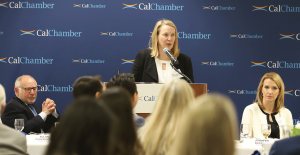

News from CalChamber
Sacramento, CA: California is now into the 11th year of the U.S. economic recovery and all of the state’s economic vitals continue to be strong, state Finance Director Keely Martin Bosler told business leaders at a California Chamber of Commerce luncheon yesterday.
Budget Is ‘Structurally Balanced’
The Department of Finance (DOF) expects the state’s economy to keep growing, though at a slower pace than before. The state saw an overall $5.6 billion surplus this year, and though the figure is lower than in previous years, Bosler cited improvements in the DOF’s ability to estimate the impact of federal tax policies on California’s revenue as the main cause.
Other positives for the state: unemployment is currently at record lows; and the state has paid off all its budgetary debts and deferrals, some of which had been on the books for more than a decade. The state also is continuing to fund long-term liabilities, Bosler said, dedicating $6 billion last year in supplemental payments to pension fund liabilities, saving the state $15 billion over a 30-year period.
Still, risks remain on the horizon, Bosler warned. In a recession scenario created by the DOF, a recession (larger than the dot-com bust, but shorter in duration than the Great Recession) would lead to a $70 billion decline in revenue over a three-year period.
“There is definitely…no resting on our laurels; we have to continue to be very laser focused on budget resiliency and on being able to handle any recession or slowdown that comes our way,” she said.
The state, Bosler explained, now has $18 billion in Rainy Day Fund reserves, which is $2 billion more than last year. The Rainy Day Fund is expected to grow to over $19 billion next year, she added.
Housing, Infrastructure
 The Governor’s 2020–2021 budget commits $331 million to set up a housing trust fund to provide legal aid protection for renters and those facing foreclosure.
The Governor’s 2020–2021 budget commits $331 million to set up a housing trust fund to provide legal aid protection for renters and those facing foreclosure.
The administration, Bosler said, also plans to turn excess state properties and lands into affordable housing units or infrastructure to service homeless populations.
But the budget alone cannot fix the housing crisis, Bosler stressed. The state will be seeking private investment to help build more housing and the budget commits an additional $500
million to the State Low Income Housing Tax Credit program.
Education
Thanks to Proposition 98, education funding is at an all-time high at $84 billion, Bosler explained.
The state has closed achievement gaps for some populations of students, such as low-income and Latino student
s, but gaps persist for other groups, such as African American and special education students. To improve education outcomes, the state will focus on:
- Increasing base pay for teachers, and investing in teacher preparedness and training;
- Providing $300 million in opportunity grants for lowest performing schools; and
- Providing $300 million in grants to build community school models.
Another major investment in the state budget is higher education, Bosler said.
“Higher education is…really a driver of innovation and job creation,” she remarked.
In addition to a 5% increase in funding to the California State University and University of California systems, the state is contributing $10 million to the universities’ online extension programs. Not to be left out, the California Community Colleges system will see increased funding in its apprenticeship programs to meet workforce needs.
Economy
Another budget aspect that Bosler highlighted was the Governor’s efforts to create jobs and build “a stronger and more inclusive economy.” To help do so, the budget:
- Expands by $1 billion the Earned Income Tax Credit;
- Supports new business creation by establishing a Minimum Franchise Tax cut for small businesses;
- Commits to $53.3 billion in infrastructure investments over the next five years, the majority of which is in transportation; and
- Funds projects in inland California, such as the construction of two new medical schools, and a $33 million private-public partnership in Fresno between the school systems and local industry to create high-wage jobs that meet education, health care, and agricultural workforce needs.
Health Care
A major priority for the Governor this year is reducing health care costs, Bosler said. The administration will be creating the Office of Health Care Affordability to focus on lowering costs, increasing transparency, analyzing hospital trends and consolidation costs, and ways to return costs to consumers.
Other objectives Bosler outlined were expanding job protections for paid family leave; strengthening the state public option; manufacturing state-branded generic drugs; and establishing a new Golden State Pricing Schedule to lower drug costs.
Medi-Cal also will be undergoing several changes to improve outcomes and achieve savings, such as investing in dental preventative care and preventative medical care to ease burdens on emergency services, she said.
Court Funding, Emergency Services
The Governor’s approach to the courts has been to focus on equity and access to justice, Bosler said. The upcoming budget will continue to invest in the judiciary by funding improvements in technology and infrastructure, and funding court navigators and civil staff.
Lastly, the budget will make additional investments in the state’s emergency infrastructure by:
- Hiring more firefighters and support staff;
- Funding more helicopters and air tanker improvements;
- Establishing a new Wildfire Forecast and Threat Center;
- Investing in new hazard assessment technology; and
- Hardening community infrastructure and forest health (through a new Climate Resilience Bond).
Comments are closed.

